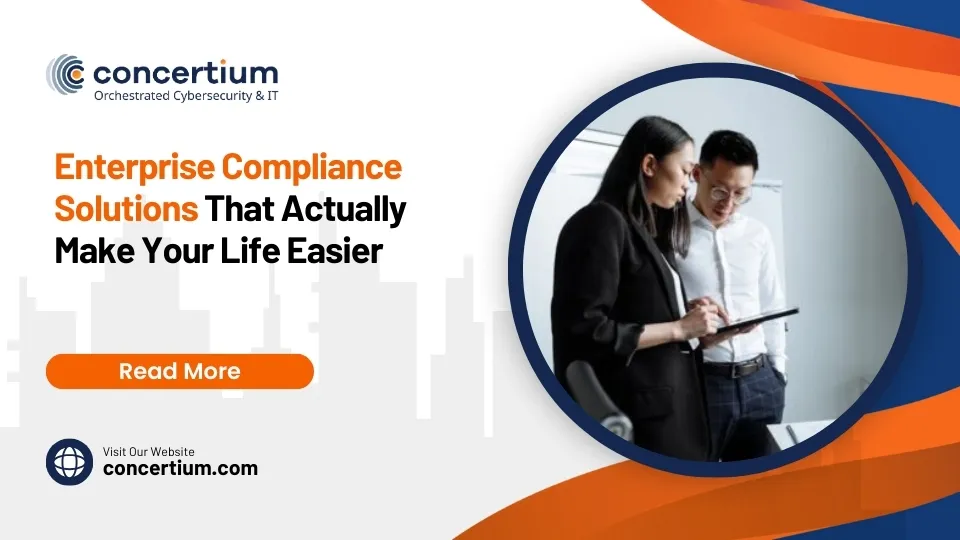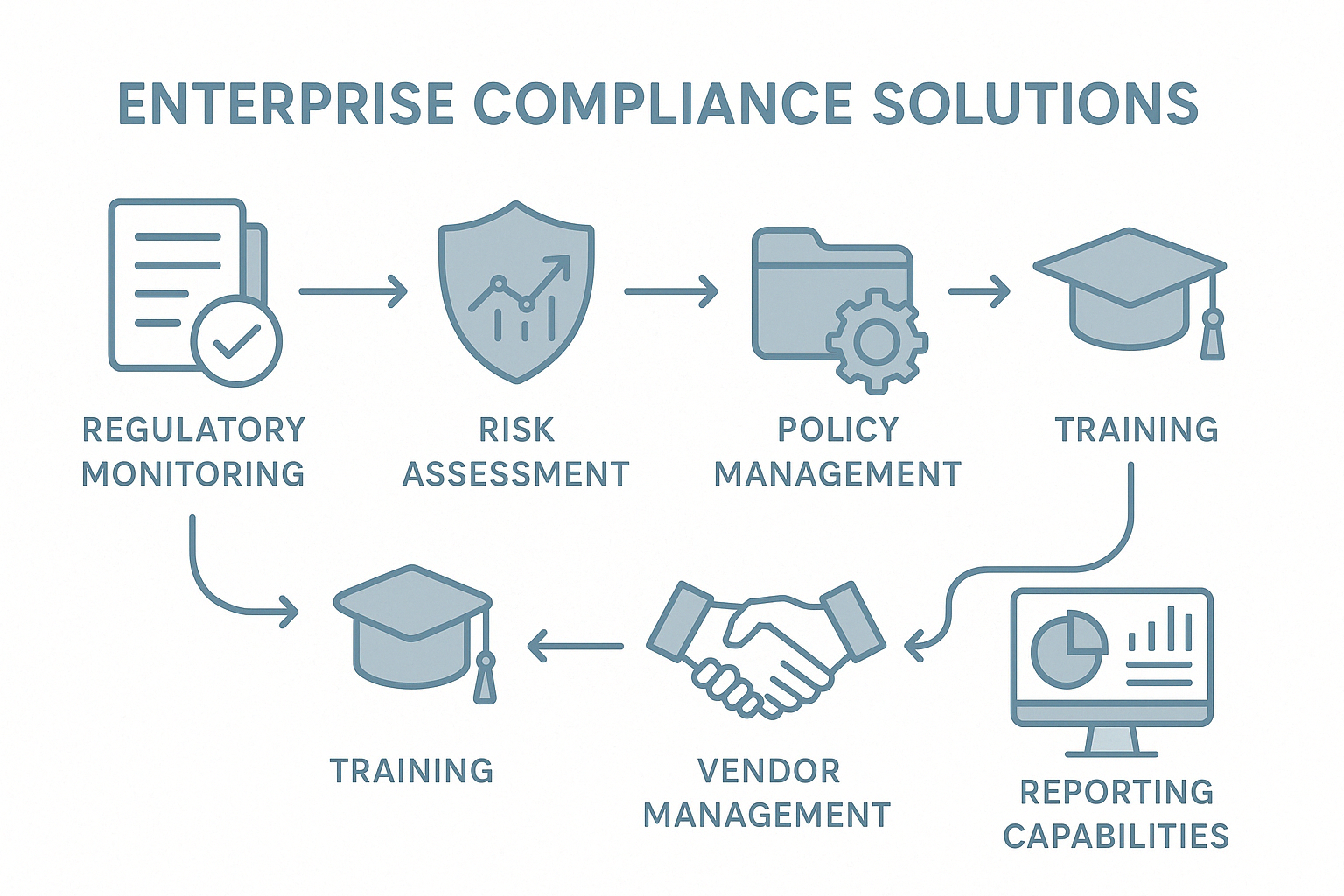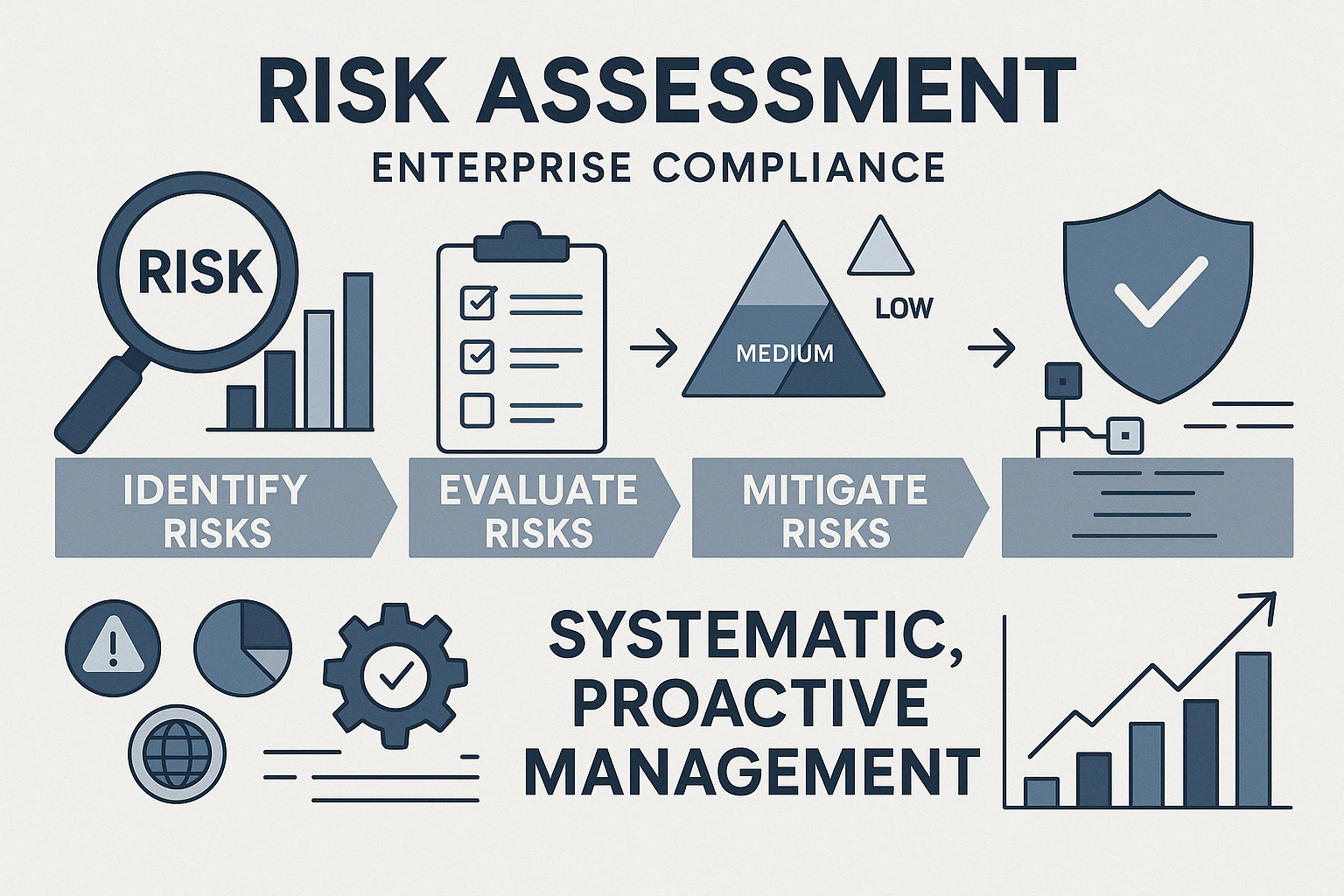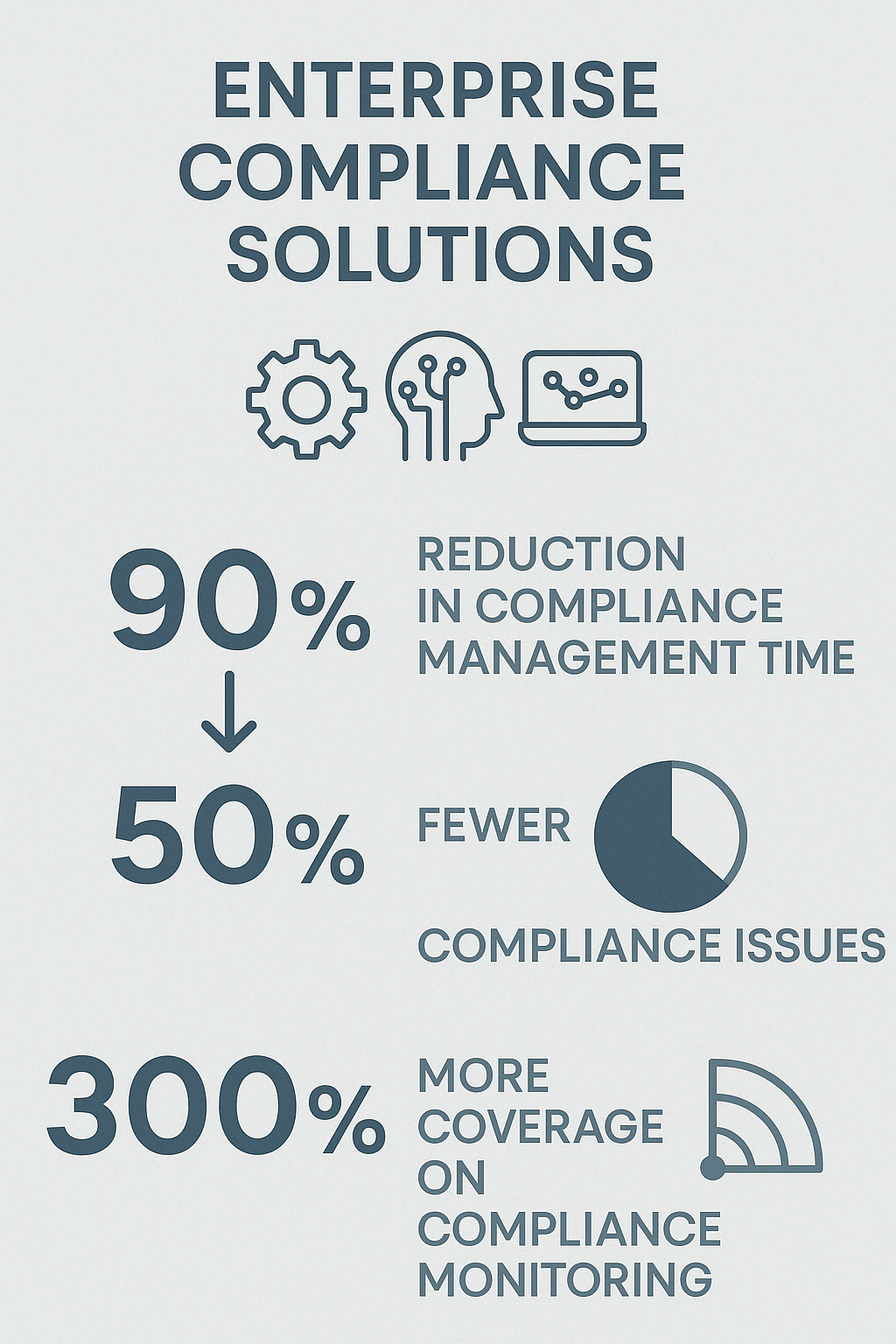Enterprise compliance solutions are integrated systems and processes that help organizations meet regulatory requirements, manage risks, and maintain ethical standards across their operations.
Key Elements of Enterprise Compliance Solutions:
- Centralized compliance management platforms
- Automated regulatory monitoring and updates
- Risk assessment and mitigation tools
- Policy management systems
- Vendor risk management capabilities
- AI-powered compliance automation
As the regulatory landscape grows increasingly complex, businesses face mounting pressure to maintain compliance across multiple jurisdictions and frameworks. According to research, 43% of organizations believe changing regulatory environments pose the greatest risk to their business, while 36% see fraud and corruption as major threats.
Modern enterprise compliance is no longer just about avoiding penalties—it’s about creating a competitive advantage. As one compliance executive noted:
“Having witnessed the profound impact of inadequate compliance on a business, I came to recognize compliance as more than just a safeguard — it can actually be a competitive advantage for organizations. By enhancing compliance efficiency, we create a win-win situation for everyone involved.”
For tech-savvy business owners managing mid-sized enterprises, the challenge lies in finding solutions that protect sensitive data and ensure regulatory compliance without disrupting core operations or requiring massive investments in specialized staff.
The good news? Today’s enterprise compliance solutions leverage automation, AI, and centralized management to dramatically reduce the manual workload—by up to 70% according to some implementations—allowing you to focus on actual risk reduction rather than paperwork.
1. Understanding Enterprise Compliance Solutions
When you’re running a business today, navigating the maze of regulations can feel like trying to solve a puzzle that keeps changing shape. That’s where enterprise compliance solutions come in – they’re your map through this complex terrain.
What Is Enterprise Compliance?
Think of enterprise compliance as your organization’s comprehensive game plan for playing by the rules. It’s not just about checking boxes on a regulatory form – it’s about weaving compliance into the very fabric of how your company operates.
Unlike the old days when each department might handle their own compliance needs separately (often leading to confusion and duplication), modern enterprise compliance solutions bring everything together under one roof. This unified approach means your HR team, finance department, and operations staff are all working from the same playbook.
The beauty of this integrated approach is that it creates consistency across your entire organization. Whether you have offices in different states or countries, everyone follows the same standards and procedures. This not only makes compliance more efficient but also builds a culture where doing things the right way becomes second nature.
As one Chief Compliance Officer from a major financial institution put it: “With comprehensive technology, we can deliver the resources and capabilities to enable the continued success of our business. The right solution addresses our broad spectrum of compliance requirements.”
Why Is Enterprise Compliance Important?
You might be wondering if all this compliance effort is really worth it. The short answer is absolutely – and it goes far beyond just avoiding fines.
Legal obligations are the most obvious reason. Breaking rules can lead to painful penalties, lawsuits, and even restrictions on how you can operate. With regulations like GDPR, CCPA, SOX, and industry-specific rules like HIPAA or FINRA, staying compliant has never been more complex – or more essential.
Your reputation is perhaps your most valuable asset. In today’s connected world, news of compliance failures spreads like wildfire. A single data breach can undo years of carefully built customer trust. In fact, research shows that 97% of business professionals recognize the importance of operating with integrity – because they know customers and partners are watching.
Surprisingly, good compliance actually boosts your operational efficiency. When you have clear guidelines and streamlined processes, you eliminate confusion and redundancy. Your team spends less time figuring out what to do and more time doing it well. Plus, you avoid the costly disruptions that come with compliance failures.
Perhaps most interestingly, strong compliance can become your competitive advantage. More and more customers prefer working with businesses they know they can trust. When you can demonstrate your commitment to ethical practices and regulatory compliance, you stand out from competitors who treat compliance as an afterthought.
At Concertium, we’ve seen how our clients transform when they stop viewing compliance as a necessary evil and start seeing it as a strategic asset. With nearly three decades in cybersecurity and compliance, we’ve helped businesses of all sizes turn regulatory challenges into opportunities for improvement and growth.
The most successful organizations understand that enterprise compliance solutions aren’t just about avoiding problems – they’re about building a stronger, more trustworthy, and ultimately more successful business.
2. Leveraging AI in Enterprise Compliance Solutions
Remember when compliance meant mountains of paperwork and endless manual checks? Those days are quickly becoming a distant memory. The marriage of artificial intelligence and enterprise compliance solutions has transformed what was once a necessary burden into a strategic advantage for forward-thinking organizations.
Automation Improves Compliance Efficiency
Let’s be honest – nobody got into business because they love paperwork. That’s why the efficiency gains from AI-powered compliance are so welcome. Our clients regularly report that automation reduces their manual compliance workload by up to 70%. That’s not just a time-saver; it’s a game-changer.
Think about what your compliance team could accomplish if they weren’t drowning in routine tasks. With AI handling the heavy lifting of document processing, your people can focus on strategic compliance initiatives that actually move the needle for your business.
One Chief Compliance Officer we partner with put it perfectly: “Before implementing AI-driven automation, our team spent approximately 60% of their time on documentation. Now that figure is closer to 20%, allowing us to focus on actual risk management.”
Beyond just processing documents, today’s AI systems embed compliance into your daily operations through workflow automation. From approval processes to scheduled assessments, policy distribution to evidence collection – these tasks happen seamlessly in the background while your team focuses on higher-value work.
Perhaps most valuable is AI’s ability to provide continuous monitoring. Unlike humans who need sleep and weekends off, AI systems vigilantly track user activities, monitor system configurations, flag unusual patterns, and update compliance dashboards in real-time. It’s like having a compliance officer who never takes a vacation.
AI for Regulatory Change Management
If keeping up with regulatory changes feels like drinking from a firehose, you’re not alone. With over 50,000 legislative changes happening annually worldwide, staying current is virtually impossible without technological assistance.
This is where AI truly shines in enterprise compliance solutions. Modern systems continuously monitor regulatory sources, instantly identifying changes relevant to your specific business. Rather than scrambling to catch up with new requirements, you can stay ahead of the curve with real-time regulatory intelligence.
The most sophisticated solutions don’t just tell you what changed – they help you understand what it means for your business. They assess the impact on your existing policies, prioritize updates based on risk levels, and even recommend specific actions to maintain compliance.
“Automating compliance processes and enhancing real‐time visibility are essential for reducing compliance violations and reputational risk.”
What’s truly exciting is the emergence of predictive compliance capabilities. Advanced AI systems can now anticipate regulatory trends based on historical data, identify potential compliance gaps before they become issues, and simulate the impact of proposed changes. It’s like having a compliance crystal ball.
At Concertium, we’ve seen how these AI capabilities transform compliance from a reactive scramble to a proactive strategy. Our AI-improved observability tools don’t just spot compliance issues – they provide clear, actionable guidance for remediation. And because our systems continuously learn from new developments, our clients stay ahead of requirements rather than constantly playing catch-up.
The best part? You don’t need to be a tech giant to benefit from these advances. Today’s enterprise compliance solutions make AI-powered compliance accessible to mid-sized organizations, providing enterprise-grade protection without enterprise-level complexity or cost.
3. Centralized Compliance Management Systems
Remember those days when compliance documents were scattered across different departments, stored in various formats, and managed by different teams? If you’re nodding your head, you’re not alone. This fragmented approach has been the norm for years—until now.
Enterprise compliance solutions have evolved dramatically, with centralized management systems emerging as game-changers for businesses struggling to keep up with regulatory demands. Think of these systems as your compliance command center, bringing order to what was once chaos.
Benefits of Centralized Systems
At the heart of modern compliance management is what we like to call the single source of truth. Rather than hunting through email threads, shared drives, or—heaven forbid—physical filing cabinets, a centralized system puts everything in one accessible place.
The benefits are immediate and substantial. Our clients report up to 90% reduction in time spent managing compliance activities after implementing a centralized approach. That’s not just saving time—it’s changing how compliance teams work.
“I used to dread audit season,” one compliance officer told us. “Now I can pull reports in minutes that used to take weeks to compile.” This confidence comes from knowing that everyone is working with the same information, eliminating contradictory guidance or outdated policies.
Improved visibility is another game-changing benefit. Imagine having a real-time dashboard showing your compliance status across the entire organization. No more guesswork about where you stand—just clear, actionable insights that help you stay ahead of issues before they become problems.
For executives and board members who need high-level views, centralized enterprise compliance solutions deliver automated reporting that cuts through the noise. Need to dive deeper into a specific area? Modern systems let you drill down to investigate patterns and address root causes.
Perhaps most importantly, centralized systems break down the silos that have traditionally hampered compliance efforts. They create spaces for cross-functional collaboration, establishing clear lines of responsibility and transparent tracking of tasks. When everyone can see who’s doing what and when it’s due, accountability naturally follows.
Streamlining Policy Management
Let’s be honest—policy management has traditionally been one of the most tedious aspects of compliance work. Writing, reviewing, distributing, and tracking policies can consume countless hours that could be better spent on strategic initiatives.
Centralized enterprise compliance solutions dramatically streamline this process. Instead of starting from scratch with each new policy, teams can work from consistent templates that ensure all necessary elements are included. Automated workflows guide documents through review and approval processes, while version control maintains a clear history of changes.
When regulations change (and don’t they always?), modern systems can trigger policy updates automatically. This integration with regulatory intelligence means you’re never caught flat-footed by new requirements.
The distribution process gets a major upgrade too. Rather than blasting the entire organization with every policy update, centralized systems enable targeted distribution based on roles and responsibilities. Marketing doesn’t need to wade through IT security policies, and finance teams don’t need detailed guidance on social media compliance.
One of the biggest headaches in traditional policy management is tracking attestations—who has acknowledged which policies and when. Centralized systems automate this process, flagging non-responsive employees and generating the evidence you’ll need when auditors come knocking.
Perhaps most valuable is the ability to map policies directly to specific regulatory requirements. This means you can quickly demonstrate how your organization addresses each compliance obligation, with clear links between requirements, internal policies, implementing controls, and supporting evidence.
A banking client we worked with summed it up perfectly: “Before our centralized system, preparing for audits was like cramming for finals—stressful, inefficient, and never quite complete. Now it’s just part of our regular workflow. The information is always there when we need it.”
At Concertium, we design centralized compliance management systems that fit seamlessly into your existing technology landscape. We focus not just on checking regulatory boxes but on creating systems that make your business run more smoothly while providing valuable insights for strategic decision-making.
Learn more about Compliance Strategies for PE & VC
4. Risk Assessment and Management Tools
At the heart of successful enterprise compliance solutions lies effective risk management. Think of it as the foundation of your compliance house—without it, everything else becomes unstable. Modern risk assessment tools have transformed how organizations approach compliance risks, shifting from putting out fires to preventing them in the first place.
Identifying and Mitigating Compliance Risks
Knowing your risks is the first step in managing them. It’s like having a map before starting a journey—you need to know where the dangerous terrain lies.
Today’s enterprise compliance solutions incorporate established frameworks that provide structure to the sometimes overwhelming task of risk identification. Whether you’re using the NIST Cybersecurity Framework, ISO 31000, or industry-specific frameworks like HITRUST for healthcare, these proven approaches help you systematically catalog potential compliance pitfalls.
But not all risks deserve equal attention. That’s where risk scoring becomes invaluable. Modern tools help you assign quantitative scores based on factors like potential financial impact, likelihood of occurrence, and regulatory consequences. This allows you to focus your limited resources where they’ll have the greatest impact.
“The ability to quantify and visualize our compliance risk exposure has transformed our approach,” shared a Chief Risk Officer we partnered with. “We now make data-driven decisions about risk acceptance versus mitigation, rather than relying on gut feelings.”
Once you’ve identified and prioritized risks, the next step is implementing and testing controls. Enterprise compliance solutions streamline this process by automating technical control testing, managing workflows for manual control verification, and tracking remediation efforts when weaknesses are found. This systematic approach ensures nothing falls through the cracks.
Continuous Monitoring for Compliance
The days of annual compliance check-ups are behind us. In today’s fast-moving regulatory environment, point-in-time assessments simply can’t keep pace with change. Modern enterprise compliance solutions accept continuous monitoring—think of it as having a 24/7 security guard rather than occasional patrols.
Real-time compliance dashboards give you instant visibility into your compliance status across multiple regulations. With the ability to drill down into specific areas and track trends over time, you can spot potential issues before they become serious problems. Different stakeholders—from executives to compliance specialists—can customize their views to focus on what matters most to them.
Behind these dashboards, automated monitoring systems work tirelessly to validate controls. Through API connections to critical systems, scheduled assessments, and continuous testing, these tools provide immediate alerts when controls fail or show signs of degradation. This early warning system is invaluable for maintaining consistent compliance.
When issues do arise, modern systems don’t just sound the alarm—they initiate action. Automated workflows notify responsible parties, track resolution progress, and document remediation actions for future audits. This structured approach ensures nothing slips through the cracks.
Perhaps most importantly, effective enterprise compliance solutions foster continuous improvement. By facilitating root cause analysis of compliance failures and identifying systemic issues, they help organizations implement preventive measures and track improvement over time. This creates a virtuous cycle where compliance becomes stronger with each passing month.
At Concertium, our nearly three decades of cybersecurity and compliance experience inform our approach to risk assessment and management. We understand that effective tools are only part of the equation—expert guidance is equally important to interpret results and develop appropriate mitigation strategies.
Our AI-improved observability capabilities watch over your compliance controls 24/7, providing early warning of potential issues. This proactive approach has helped our clients reduce compliance incidents by up to 60% while simultaneously lightening the resource burden of compliance management. After all, the best compliance problems are the ones you prevent rather than fix.
5. Vendor Risk Management Solutions
When it comes to enterprise compliance solutions, there’s a truth we’ve learned from working with hundreds of clients: your compliance is only as strong as your weakest vendor. Think of it like a chain – one weak link can compromise everything you’ve worked so hard to protect.
Importance of Managing Vendor Risks
Remember the last major data breach that made headlines? Chances are, it involved a third-party vendor. This shouldn’t be surprising – today’s businesses don’t operate in isolation. You likely depend on dozens, perhaps hundreds, of vendors who have varying levels of access to your systems, data, and facilities.
This extended network creates what we call an “extended compliance perimeter.” Your vendors essentially become extensions of your own organization, at least from a risk perspective. When they handle your customer data, access your systems, or represent your brand, their compliance failures become your problem.
Regulators understand this reality all too well. That’s why frameworks like GDPR specifically address data processors (your vendors), HIPAA includes provisions for business associates, and financial regulations mandate thorough vendor due diligence. These aren’t optional considerations – they’re legal requirements with serious consequences.
What makes vendor risks particularly challenging is the reputational aspect. Your customers don’t distinguish between “your mistake” and “your vendor’s mistake” – they simply see a failure that affects them. A compliance lapse by a third party can damage your reputation just as severely as an internal issue, sometimes more so if it appears you didn’t properly vet your partners.
Industry research backs this up with sobering statistics: third-party breaches typically cost significantly more than internal incidents. They’re harder to detect, more complex to address, and often more damaging to customer trust.
Effective Vendor Compliance Strategies
Fortunately, modern enterprise compliance solutions offer powerful tools to tame this complexity. At Concertium, we’ve helped clients transform vendor management from a paperwork nightmare into a strategic advantage.
The foundation of effective vendor management starts with risk assessment. Think of this as your vendor triage system – not all vendors pose the same level of risk. A cloud provider hosting your sensitive customer data requires much more scrutiny than your office supply company. Advanced solutions enable you to create standardized assessments that automatically categorize vendors based on risk factors like data access, system connectivity, and regulatory impact.
Due diligence is where the real work happens. Before signing that contract, you need visibility into a vendor’s compliance history, security practices, and financial stability. This isn’t about creating bureaucratic problems – it’s about starting relationships on the right foot, with clear expectations and appropriate safeguards.
Speaking of contracts – they’re your primary tool for establishing compliance expectations. Modern enterprise compliance solutions typically include contract templates with appropriate compliance language, right-to-audit provisions, and breach notification requirements. These aren’t just legal formalities; they’re practical tools that define how you’ll work together when (not if) issues arise.
But vendor management isn’t a one-and-done activity. The most effective approach involves continuous monitoring of your vendor ecosystem. This might include periodic reassessments, integration with external risk intelligence sources, and automated alerts when a vendor’s risk profile changes. Think of it as an early warning system that helps you address small issues before they become compliance disasters.
One healthcare compliance manager we worked with put it perfectly: “Before implementing structured vendor risk management, we were essentially hoping for the best. Now we have visibility into our vendors’ compliance practices and can address issues before they become problems.”
At Concertium, we’ve spent nearly three decades helping organizations build effective vendor risk management programs. We understand that technology alone isn’t enough – you need the right methodology, efficient processes, and expert guidance to steer the complexities of third-party compliance.
Our approach combines powerful technological tools with practical expertise, helping you transform vendor relationships from potential liabilities into strategic assets that strengthen rather than undermine your overall compliance posture.
Learn more about Compliance Risk Management Services
Frequently Asked Questions about Enterprise Compliance Solutions
What Are the Key Components of an Effective Enterprise Compliance Program?
Building an effective enterprise compliance solution isn’t about checking boxes—it’s about creating a living, breathing system that protects your organization while enabling growth. When our clients ask what makes compliance programs actually work, we focus on six essential elements that need to work in harmony.
At the foundation of every successful program is a comprehensive compliance framework. Think of this as your compliance blueprint—it clearly defines who’s responsible for what, documents which regulations apply to your business, and maps those requirements to your specific processes. One banking client told us, “Having this framework was like turning on the lights in a dark room—suddenly we could see exactly what we needed to do.”
Equally important are robust policies and procedures that translate regulatory requirements into practical guidance. The best policies aren’t just written—they’re communicated, understood, and followed. They’re living documents that evolve as regulations change. We’ve found that accessibility is key here—compliance documents gathering digital dust in a forgotten folder help no one.
No compliance program succeeds without effective training and awareness programs. Your team can’t comply with rules they don’t understand. Role-based training ensures everyone learns what’s relevant to their specific responsibilities, while regular refreshers keep compliance top of mind. As one compliance executive noted: “The most effective compliance programs aren’t just about having the right components—they’re about how those components work together to create a culture where compliance becomes part of everyday operations rather than a separate activity.”
The monitoring piece is where many programs fall short. Regular assessments and continuous monitoring provide visibility into your compliance status. Think of it as your compliance dashboard—showing you where you’re on track and where you need attention before small issues become big problems.
When issues do arise—and they will—having structured issue management processes makes all the difference. This includes clear channels for reporting concerns, defined workflows for addressing them, and root cause analysis to prevent recurrence. One healthcare client told us, “Having a process turned compliance failures from crises into improvement opportunities.”
Finally, thorough documentation and reporting ties everything together. This isn’t just about satisfying auditors (though it certainly helps there). Good documentation provides insights that drive improvement and demonstrates your commitment to compliance when questions arise.
How Do Enterprise Compliance Solutions Improve Decision-Making?
In today’s data-driven business environment, modern enterprise compliance solutions have transformed from simple rule-enforcement tools into powerful decision-making engines. The best solutions provide leaders with insights that inform strategic choices and operational decisions.
The shift to data-driven insights has been game-changing for our clients. Instead of relying on gut feelings about compliance risks, they now have quantitative assessments and comprehensive dashboards showing exactly where they stand. This objective view helps prioritize investments and identify the most pressing compliance challenges before they become problems.
Perhaps even more valuable is the real-time information these solutions provide. “Before implementing our compliance platform, we were always looking in the rearview mirror,” a CFO client told us. “Now we can see compliance implications of business decisions before we make them.” This visibility helps prevent costly missteps and ensures compliance considerations are part of the conversation from the beginning.
The ability to conduct scenario analysis takes decision support to another level. Modern solutions allow you to model different approaches—whether you’re considering entering a new market, launching a product, or changing a business process—and understand the compliance implications of each option. This forward-looking capability turns compliance from a reaction to a strategic advantage.
Finally, enterprise compliance solutions provide crucial insights for resource optimization. They show which compliance investments are delivering results and which might be overkill. In an era of constrained resources, this data helps compliance teams focus their efforts where they’ll have the greatest impact.
A CFO we worked with recently shared: “Our compliance solution has transformed how we make business decisions. We now have clear visibility into the compliance implications of different options, allowing us to factor compliance into our strategic planning rather than dealing with it as an afterthought.”
How Can Technology Improve Compliance Efforts?
Technology has revolutionized compliance management, turning what was once a labor-intensive burden into a streamlined, efficient function. The right tools don’t just make compliance easier—they make it more effective.
Automation tools have perhaps the most immediate impact. Tasks that once consumed hours of valuable time—distributing policies, collecting attestations, gathering evidence for audits—now happen with minimal human intervention. One client told us they reduced time spent on routine compliance tasks by over 80%, freeing their team to focus on strategic risk management rather than paperwork.
The integration of artificial intelligence is taking compliance to new heights. Natural language processing can analyze complex regulations and extract relevant requirements. Machine learning algorithms detect unusual patterns that might indicate compliance issues. Predictive analytics help identify emerging risks before they materialize. These capabilities transform compliance from reactive to proactive.
Centralized platforms solve one of the most persistent challenges in compliance management: fragmentation. Having a single source of truth for all compliance information eliminates inconsistencies, reduces duplication, and provides a complete view of your compliance posture. “Before our platform, we had compliance information scattered across dozens of systems and hundreds of spreadsheets,” a compliance director told us. “Finding anything was a treasure hunt. Now it’s all at our fingertips.”
Modern solutions also offer powerful integration capabilities that embed compliance into everyday business processes. Rather than being a separate activity, compliance becomes part of normal workflows. Real-time connections to operational systems provide continuous monitoring, while mobile access ensures compliance isn’t confined to the office.
The results speak for themselves. Organizations leveraging advanced technology for compliance management have achieved remarkable improvements:
At Concertium, we’ve seen how technology transforms compliance from a burdensome necessity to a strategic advantage. Our clients report not only improved compliance outcomes but also significant operational benefits from implementing modern enterprise compliance solutions.
Conclusion
The evolution of enterprise compliance solutions represents one of the most significant shifts in how businesses approach regulatory requirements. What was once a tedious checkbox exercise has transformed into an intelligent, integrated system that genuinely makes compliance management more straightforward while strengthening your organization’s overall posture.
Throughout our exploration, we’ve seen that today’s most effective enterprise compliance solutions share several essential characteristics. They’re integrated, connecting compliance activities seamlessly across departments rather than treating them as isolated tasks. They leverage automation, dramatically reducing the manual effort and human error that plague traditional compliance approaches. They incorporate intelligence through AI and analytics, enabling proactive rather than reactive compliance management. They provide centralization, creating a single source of truth for all compliance information. And perhaps most importantly, they’re comprehensive, addressing the full spectrum of requirements facing modern organizations.
At Concertium, we’ve learned through nearly three decades of experience that compliance isn’t merely about avoiding problems—it’s about creating a solid foundation for sustainable business growth. Our approach combines cutting-edge technology with deep expertise to deliver systems that ensure regulatory adherence while simultaneously improving operational efficiency.
Our Collective Coverage Suite (3CS) with AI-improved observability gives organizations the visibility and intelligence needed to maintain compliance in today’s increasingly complex regulatory environment. By automating routine tasks and providing actionable insights, we help our clients transform compliance from what many perceive as a cost center into a genuine competitive advantage.
The regulatory landscape will undoubtedly continue to evolve, with new requirements emerging and existing ones becoming more stringent. Organizations that implement robust enterprise compliance solutions now will find themselves well-positioned to adapt to these changes while maintaining their operational momentum.
We’ve also finded that effective compliance goes beyond having the right technology—it’s about fostering a culture where compliance is valued and woven into the fabric of everyday business operations. The best solutions support this cultural shift by making compliance more accessible, understandable, and manageable for everyone in the organization, not just the compliance team.
Are you ready to transform your approach to compliance? We invite you to explore how Concertium’s customized enterprise compliance solutions can help your organization not just meet regulatory requirements but truly thrive in an increasingly complex business environment.
Learn more about Vulnerability Risk Management
By implementing the right approach to compliance, you can turn what many businesses view as a necessary burden into a genuine business advantage—protecting your organization while simultaneously enabling growth and innovation. That’s the kind of compliance that actually makes your life easier, and your business stronger.








